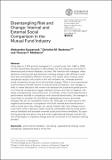Disentangling Risk and Change: Internal and External Social Comparison in the Mutual Fund Industry
Author(s)
Kacperczyk, Aleksandra Joanna; Beckman, Christine M.; Moliterno, Thomas P.
DownloadKacperczyk-2015-Disentangling risk.pdf (178.5Kb)
PUBLISHER_POLICY
Publisher Policy
Article is made available in accordance with the publisher's policy and may be subject to US copyright law. Please refer to the publisher's site for terms of use.
Terms of use
Metadata
Show full item recordAbstract
Using data on 3,225 actively managed U.S. mutual funds from 1980 to 2006, we test hypotheses designed to disentangle risk and change as outcomes of behavioral performance feedback routines. We theorize that managers make decisions involving risk and decisions involving change under different conditions and motivated by different concerns. Our results show internal social comparison across units within a firm will motivate risk, whereas external social comparison across firms will motivate change. When a fund experiences a performance shortfall relative to internal social comparison, the manager is likely to make decisions that involve risk because the social and spatial proximity of internal comparisons trigger individual concern and fear of negative individual consequences, such as job loss. In contrast, when a fund experiences a performance shortfall in comparison with external benchmarks, the manager is more likely to consider the shortfall an organizational concern and make changes that do not necessarily involve risk. Although we might assume that negative performance in comparison with both internal and external benchmarks would spur risky change, our results indicate that risky change occurs most often when a decision maker receives unfavorable internal social performance feedback and favorable external social performance feedback. By questioning assumptions about why and when organizational change involves risk, this study begins to separate change and risk outcomes of the decision-making process.
Date issued
2014-12Department
Sloan School of ManagementJournal
Administrative Science Quarterly
Publisher
Sage Publications
Citation
Kacperczyk, A., C. M. Beckman, and T. P. Moliterno. “Disentangling Risk and Change: Internal and External Social Comparison in the Mutual Fund Industry.” Administrative Science Quarterly 60, no. 2 (December 29, 2014): 228–262.
Version: Final published version
ISSN
0001-8392
1930-3815